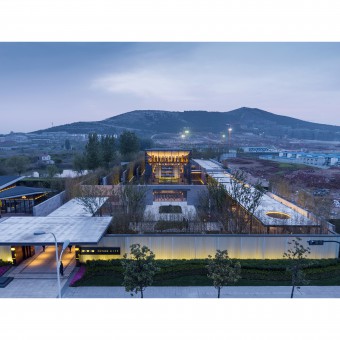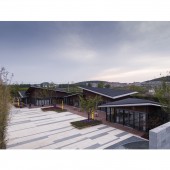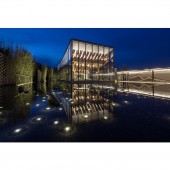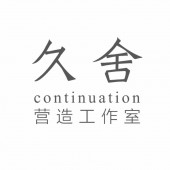Vanke Future Town Demonstration Area by Fan Jiujiang |
Home > Winners > #62267 |
 |
|
||||
| DESIGN DETAILS | |||||
| DESIGN NAME: Vanke Future Town PRIMARY FUNCTION: Demonstration Area INSPIRATION: Inspired by Chinese traditional bridges, the designers apply its structural beauty to the project after studying these traditional bridges and hand modelling their long span structure constructed of short timbers, as a tribute to the traditional Chinese craftsmanship. As in this project, the bridge structure is introduced into the large scale exhibition space, as a piece of expressive element to be viewed from below, as a demonstration of Vanke's technical strength and value. It is also reflected in the water patio in front of the main space. UNIQUE PROPERTIES / PROJECT DESCRIPTION: Located by the Yunlong Lake in Xuzhou, occupying over a million square metres, the launched project Vanke Future Town is a grand community with abundant landscape resources, wherein the demonstration area, as the first set of architectures to make an entrance to the land, will set the tone for the whole ongoing project. The sales exhibition centre (which will later be converted into a community centre) is designed to be in proportion with and reflects the vast scale of Future Town and the geographical structure of the city. OPERATION / FLOW / INTERACTION: The timber piece does not act as the major structure in the force bearing system. Instead, it is supported by a group of 8 steel columns and suspended from steel beams hidden in a roof above. The latter reinforcement dismisses the lack of lateral resistance in the previous approach as the piece hits mid-air. It, although, has been a great pity, since the timber piece does not physically act as a bridge, by which it is inspired. PROJECT DURATION AND LOCATION: The project was designed between September 2016 to November 2016. And the construction is completed in March 2017 in Xuzhou, Jiangsu, China. FITS BEST INTO CATEGORY: Architecture, Building and Structure Design |
PRODUCTION / REALIZATION TECHNOLOGY: Small spaces for the entrance hall, screening rooms, separate meeting rooms and rear services, etc., is compressed into the east wing, ensuring a single piece of large scale space for exhibition in the main building. This layout has granted the main building an open floor plan to achieve the multiple functions that it requires for exhibitions and as a community centre. Meanwhile, the abundant glazing of the facade gives views out to the city, reducing the architectural volume as it connects with the external space, enhancing its public characteristic. SPECIFICATIONS / TECHNICAL PROPERTIES: 600mmx200mm glued laminated timbers with different lengths are used as basic components. Moreover, the part works as a horizontal fulcrum between the upper and lower timbers in the original bridge structure is replaced by steel tubes, which now support the timbers by weaving in where they interlock together. With this approach, different from the unidirectional arch the original structure performs for pressure-bearing, it establishes a system of continuous triangles and inverted triangles, which slopes rather gently in comparison to the original. TAGS: Traditional Bridge, Vanke, Demonstration Area, Planning, Architecture RESEARCH ABSTRACT: If it weren't for this tradeoff, however, the construction wouldn't have been simplified, in order to be accomplished with the given time as short as 7 months. It also endows a visual sensation of floating to the space, when the suspended lumbersome looking timber piece appears to be levitating in the air, making a striking contrast with the lightsome roof above. The recreation of impression on the place from where I gazed upon the bridge underneath is effectuated. CHALLENGE: The authenticity of the structure and the recreation of the spatial impression have been discussed repeatedly in the studio as the project progresses. As we attempted to apply the structure as a ceiling that acts as a part of a force bearing structure, its stiffness and bearing capacity has gone through calculation to meet the requirements. However, the force bearing structure it forms with a group of pillars is still not able to resist lateral force when being up in mid air. In addition, in our original proposal, the glass curtain walls with group of glass ribs was adopted, which was suspended from the timber structure ceiling. ADDED DATE: 2017-11-15 06:46:04 TEAM MEMBERS (5) : Lead Architect: Jiu-jiang Fan, Lead Architect: Wen-ting Zhai, Lead Architect: Yu Kai, Lead Architect: Shen Feng-Jia and Lead Architect: Dong Run-Jin(intern) IMAGE CREDITS: Image #1: Photographer SHIROMIO Studio, Xuzhou, 2017 Image #2: Photographer SHIROMIO Studio, Xuzhou, 2017 Image #3: Photographer SHIROMIO Studio, Xuzhou, 2017 Image #4: Photographer SHIROMIO Studio, Xuzhou, 2017 Image #5: Photographer SHIROMIO Studio, Xuzhou, 2017 |
||||
| Visit the following page to learn more: http://kks.me/au2pq | |||||
| AWARD DETAILS | |
 |
Vanke Future Town Demonstration Area by Fan Jiujiang is Winner in Architecture, Building and Structure Design Category, 2017 - 2018.· Press Members: Login or Register to request an exclusive interview with Fan Jiujiang. · Click here to register inorder to view the profile and other works by Fan Jiujiang. |
| SOCIAL |
| + Add to Likes / Favorites | Send to My Email | Comment | Testimonials | View Press-Release | Press Kit |







